The midbrain dopaminergic pathways
The midbrain dopaminergic pathways originate from the ventral tegmental area (VTA) and substantia nigra (SN) and are the major source of dopamine in the brain. Named after their place of origin and target innervation area, the mesocortical, the mesolimbic and the nigrostriatal pathway play a central role in brain functions and disorders.

..................................................
BMP5/7 are new drug candidates for Parkinson's disease offering promise to impede progression of the illness
Parkinson's disease, affecting over 10 million people worldwide, is characterized by the progressive degeneration of dopamine-secreting brain cells causing severe movement impairments. Today, it is thought that the protein alpha-synuclein, which is present in all human brains, plays a central role in the development of Parkinson's disease by misfolding and forming toxic clumps in dopamine-secreting brain cells of affected individuals. Currently, all therapies used for Parkinson's disease improve symptoms, however, their efficacy is unacceptably low in advanced stages of the illness and unfortunately, they do not stop or slow the disease progression.
Recently, we discovered that in dopamine-producing brain cells of Parkinson's disease patients bone morphogenetic protein (BMP) signaling was significantly reduced - a change that could possibly contribute to the development of the disease. To study this possibility, we genetically engineered mouse brains to reduce BMP signaling in dopamine-producing brain cells. Confirming our suspicion, reduced BMP signaling indeed lead to an accumulation of toxic alpha-synuclein clumps and loss of dopamine-producing brain cells.
We then hypothesized that if a lack of BMP signaling causes the loss of dopamine-producing brain cells, then administering BMPs could protect these cells in a Parkinson's disease model. Indeed, we found that BMP5/7 treatment could, in a Parkinson's disease mouse model, efficiently prevent the accumulation of alpha-synuclein, loss of dopamine-producing brain cells and associated movement impairments. These findings suggest that BMP5/7 could slow or stop the progression of Parkinson's disease. Currently, we are focusing our efforts on bringing our discovery closer to clinical application.

|
Immunostaining of substantia nigra dopaminergic
neurons visualized by tyrosine hydroxylase (TH). BMP5/7 delivered by a gene
therapy approach into the striatum can reverse the loss of dopaminergic neurons
caused by the viral overexpression of human mutated A53T α-synuclein (Vitic et al.,
2020). (The
data in graphs represent the mean ± standard error of the mean (SEM). *p < 0.05, **p < 0.01, ***p<0.001
Fisher’s LSD post-hoc test, after significant
one-way ANOVA
|
Reference: Vitic et al., BMP5/7 protect dopaminergic neurons in a alpha-synuclein mouse model of Parkinson's disease, Brain*. 2021 Mar 3;144(2):e15.
* The journal "Brain" is ranked accroding to its impact factor among the top 3% of neurology journals.
..................................................
The BMP/SMAD pathway promotes neurogenesis of midbrain dopaminergic neurons in vivo and in human induced pluripotent and neural stem cells

|
We identified BMP/SMAD signaling as a novel essential pathway regulating the development of midbrain dopaminergic neurons in vivo and provided insights into the molecular mechanisms of this process. Importantly, we could show with our collaborators that BMPs increase the differentiation of human induced pluripotent and induced neural stem cells to dopaminergic neurons. BMP/SMAD are routinely inhibited in initial stages of stem cell differentiation protocols currently being developed for Parkinson's disease cell replacement therapies. Therefore, our findings on opposing roles of the BMP/SMAD pathway during in vitro dopaminergic neurogenesis might improve these procedures significantly.
|
Reference: Jovanovic et al., BMP/SMAD pathway promotes neurogenesis of midbrain dopaminergic neurons in vivo and in human induced pluripotent and neural stem cells
The Journal of Neuroscience 2018 Feb 14;38(7):1662-1676. * Selected as cover story.
..................................................